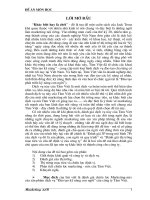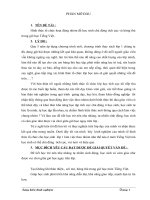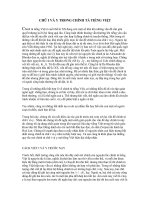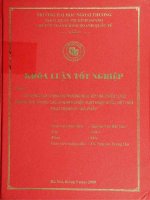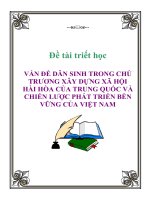Chiến lược dịch thêm và lược dịch trong bản dịch tiếng việt tác phẩm
Bạn đang xem bản rút gọn của tài liệu. Xem và tải ngay bản đầy đủ của tài liệu tại đây (794.7 KB, 89 trang )
VIETNAM NATIONAL UNIVERSITY, HANOI
UNIVERSITY OF LANGUAGES AND INTERNATONAL STUDIES
FACULTY OF ENGLISH LANGUAGE TEACHER EDUCATION
GRADUATION PAPER
OMISSION AND ADDITION IN THE VIETNAMESE
TRANSLATION OF FRANCES HODGSON BURNETT’S
THE SECRET GARDEN
Supervisor: Ngô Hà Thu, MCS
Student: Lê Thị Thùy Linh
Course: QH2011.F1.E19
HÀ NỘI – 2015
ĐẠI HỌC QUỐC GIA HÀ NỘI
TRƯỜNG ĐẠI HỌC NGOẠI NGỮ
KHOA SƯ PHẠM TIẾNG ANH
KHÓA LUẬN TỐT NGHIỆP
CHIẾN LƯỢC DỊCH THÊM VÀ LƯỢC DỊCH TRONG
BẢN DỊCH TIẾNG VIỆT TÁC PHẨM KHU VƯỜN BÍ
MẬT CỦA TÁC GIẢ FRANCES HODGSON BURNETT
Giáo viên hướng dẫn: Th.S. Ngơ Hà Thu
Sinh viên: Lê Thị Thùy Linh
Khóa: QH2011.F1.E19
HÀ NỘI – 2015
STATEMENT OF ACCEPTANCE
I hereby state that I: Lê Thị Thùy Linh from class QH2011.F1.E19, being a
candidate for the degree of Bachelor of Arts (TEFL) accept the requirements of the
College relating to the retention and use of Bachelor’s Graduation Paper
deposited in the library.
In terms of these conditions, I agree that the origin of my paper deposited in
the library should be accessible for the purposes of study and research, in
accordance with the normal conditions established by the librarian for the care,
loan or reproduction of the paper.
Signature
Date
i
ACKNOWLEDGEMENTS
I would like to express my deep and sincere thank to Ms. Ngo Ha Thu, MCS for
her guidance and motivation during the entire process of conducting this graduation
paper. Her constructive mentorship was actually of paramount significance in
providing me with necessary knowledge and experience to have this paper carried out
and completed. In addition, following Ms. Thu’s guidance also motivated me to
maintain a serious and determining attitude throughout the conduction of this research
so as to finish it on schedule with the best quality as possible.
I would also like to be extremely grateful to Mr. Nguyen Tuan Khanh, the
translator of The Secret Garden, for his great cooperation in providing responses for
the questionnaire and participating in the semi-structured interview. Though the
translator was in process of disease treatment, he still appeared quite enthusiastic and
helpful to respond to all of the questions so that I could gather the primary data that
were necessary for deeper analysis on the issue. As such, but for the translator’s
persistent support, this thesis would not have been possible.
Finally, I would like to thank all of my classmates and fellows majoring in
English Translation and Interpreting for their cooperation in taking part in the
questionnaire to supply precious data for my study. Moreover, a special thank would be
given to my friends and family who always stood by my side and persistently
encouraged me to work hard for the dissertation.
ii
ABSTRACT
The goals of this study are to identify and investigate the application of
omission and addition strategies in the Vietnamese translation of The Secret Garden by
Nguyen Tuan Khanh as well as to examine the perspectives held by chosen readers and
the translator toward these applications. The idea is to reinforce the roles of addition
and omission during the translation process as two translation strategies instead of
miscues.
Data for this study were obtained through the help of questionnaire and
interview. Firstly, the questionnaire was delivered to a number of selected readers in
order to get their ideas on the issue, particularly if they are favored or infavored of
addition and omission applications together with the reasons for their choice. A
questionnaire was also distributed to the translator in order to discover the motives for
his applications of the two strategies and compare them with the readers’ opinions.
Furthermore, a semi-structured interview with the translator was conducted with the
aim of getting the translator’s perspectives on the employment of addition and
omission during translation process in general.
On the basis of the results of this research, it can be concluded that addition
strategy tends to be utilized more than omission, and most of the instances detected in
the case study is favored by readers. One interesting point can be found is that the
translator did make a lot of assumptions about readers when translating the novel, and
these assumptions actually match with the majority of respondents’ opinions on the
topic of reasons for the applications of those investigated addition and omission
phenomena. Moreover, the data also support the expectation that addition and omission
play a certain role when translators render messages from one language to another.
iii
TABLE OF CONTENTS
CHAPTER 1: INTRODUCTION............................................................................................ 1
1.1. Statement of the problem and rationale for the study: .............................................. 1
1.2. Research objectives, research questions, significance and scope of the study .......... 2
1.2.1. Research objectives ................................................................................................. 2
1.2.2. Research questions .................................................................................................. 2
1.2.3. Significance of the study ......................................................................................... 3
1.2.4. Scope of the study .................................................................................................... 3
CHAPTER 2: LITERATURE REVIEW ............................................................................... 5
2.1. Definition of Translation ............................................................................................... 5
2.2. Translation Strategies .................................................................................................... 6
2.3. Addition and Omission .................................................................................................. 9
2.3.1. Addition .................................................................................................................... 9
2.3.2. Omission ................................................................................................................ 15
CHAPTER 3: METHODOLOGY ........................................................................................ 20
3.1. Research methods......................................................................................................... 20
3.2. Selection of subjects ..................................................................................................... 21
3.3. Data collection instruments ......................................................................................... 21
3.4. Data collection procedures .......................................................................................... 22
CHAPTER 4: DISCUSSION AND FINDINGS ................................................................... 23
4.1. Discussion on investigated materials .......................................................................... 23
4.1.1. The application of addition strategy .................................................................... 24
4.1.2. The frequency of omission types .......................................................................... 28
iv
4.2. Discussion on questionnaire on addition and omission strategies: Reasons for the
applications of addition and omission and the respondents’ perspectives toward those
applications .......................................................................................................................... 33
4.2.1. Reasons for addition instances and respondents’ perspectives toward the
applications ...................................................................................................................... 33
4.2.2. Reasons for omission instances and respondents’ perspectives toward the
applications ...................................................................................................................... 43
4.3. Discussion on the interview with translator about his perspectives toward the
applications of addition and omission when translating The Secret Garden ................. 52
4.4. Implication .................................................................................................................... 56
CHAPTER 5: CONCLUSION .............................................................................................. 57
5.1. Summary of Findings ................................................................................................... 57
5.2. Strengths and Weaknesses .......................................................................................... 59
5.3. Suggestions for further study ...................................................................................... 59
v
LIST OF FIGURES AND ABBREVIATIONS
List of figures
Figure 1. Frequency of addition types (p.23)
Figure 2. Frequency of omission types (p.28)
Abbreviations
ST: Source text
TT: Target text
SL: Source language
TL: Target language
vi
CHAPTER 1: INTRODUCTION
In this chapter, the focus is placed on rationale, research objectives, research
questions, significance and scope of the study.
1.1. Statement of the problem and rationale for the study
Now that the whole world is coming together on the basis of sharing information
and communication advances, it is evidentthat there has been a constant demand and an
unprecedented need for translation of ideas from one language into another. As such,
translation serves as an “ice breaker” which helps bringing people around the world
close to each other. In the translation process, translators have to deal between two
languages with different cultures. On this issue, Louise M. Haywood from the
Universityof Cambridge proposes that “translation is not just a movement betweentwo
languages but also between two cultures” (1995, p.135). As a result, it remains
problematic and controversial to question that whether the translation can produce the
same meaning or message in the target language text as the author intended. This
problem of equivalence has been elaborated within the field of translation by many
scholars such as Vinay and Darbelnet (1995), Jakobson (1959), Nida and Taber
(1982), Catford (1965), House (1977) and Baker (1992), in which they classify various
problems of equivalence in translation and suggest a number of strategies to deal with
them. Among the strategies suggested, the researcher would like to concentrate on
addition and omission since technically they are directly involved in the loss and gain
in terms of meaning of the translation.
The case study of this research is the Vietnamese translation of The Secret Garden
by Nguyen Tuan Khanh, in the light that the translator strives to properly reproduce the
prose fiction by using a number of translation strategies, including addition and
omission. Though the terms addition and omission have been mentioned for so long by
the main figure in the founding of Translation Studies, Peter Newmark (1988a), it
1
seems that he only spares little analysis on the issues. Besides, being a student
majoring in translation and interpreting, the researcher always finds it exhilarating to
study the original and translated versions of many literary works because, by carefully
analyzing the translations, there can be many invaluable lessons she can unexpectedly
learn from them such as how to handle specific difficult texts and select appropriate
translation strategies. Coincidentally, the translation of The Secret Garden is an
excellent case in which the researcher comes across various instances of addition and
omission and subsequently draws out interesting lessons. Considering this situation, the
researcher can find a strong drive to conduct this research in order to provide a more
detailed insight about the employment of addition and omission strategies in translation.
By studying the translated version, the researcher proposes to discuss how addition and
omission are applied in the translation as well as to examine the perspectives held by
fourth-year students majoring in English Translation and Interpreting of ULIS – VNU
(batch QH2011) and the translator toward these applications.
1.2. Research objectives, research questions, significance and scope of the
study
1.2.1. Research objectives
The study mainly aims at investigating the application of omission and addition
strategies in the translated version The Secret Garden by Nguyen Tuan Khanh. Another
goal of the research is to examine the thoughts of a number of chosen readers and the
translator about each case that employs omission or addition strategy.
1.2.2 .Research questions
Question 1: How omission and addition strategies are applied in the translation of
The Secret Garden?
2
Question 2: What are the reasons for those additions and omissions according to
(1) the translator and (2) the sample readers? Are the additions and omissions favored
or unfavored by the readers?
Question 3: What are the translator’s perspectives toward the application of
additions and omissions in the novel and in general?
1.2.3. Significance of the study
This research will be particularly helpful for students who take an interest in
literary translation, especially the translation of English literature into Vietnamese.
The first and foremost significance of the study is that it will provide a literature
review on addition and omission strategies elaborated by specific examples. Given that
these procedures have not been included in the translation theory textbook for students
majoring in English Translation and Interpreting, the synthesis of theories on addition
and omission may serve as a reference for them to diversify their application of
different shifts in the translation process. Moreover, the research also presents opinions
and ideas obtained from a group of sampled readers about the effects of addition and
omission employed in the work, which eventually may act as one of the essential basis
for translation quality assessment.
1.2.4. Scope of the study
Though the translator might use quite a number of different strategies in translating
the work, the researcher will only investigate the application of addition and omission.
As can be seen right from the title, the research will be conducted with a case study of
the whole 25 chapters of the story. From the researcher’s initial observation, this
translation presents quite a number of addition and omission examples, at both word
level and above-word level; however, due to constraint of time, knowledge and
translating competence, the researcher would like to focus on word level only in order
to achieve depth on the issue. Concerning participants of the study, only fourth-year
students majoring in English Translation and Interpreting of ULIS – VNU
(batchQH2011) will be included. Since these students should be competent in both
3
English (B2-C1 Level of CEFR) and Vietnamese, they would be likely to understand
thoroughly the examples in both English and Vietnamese and so be able to provide
response to the use of addition and omission in the case study.
4
CHAPTER 2: LITERATURE REVIEW
This chapter will briefly present some information relating to translation in
general and provide an insight about the definitions as well as classifications of the
two strategies addition and omission to serve as a theoretical basis for the study.
2.1. Definition of Translation
On the account of inter-lingual communication, translation is used asa generic
term, including two different streams which are written translation and oral translation.
Professionally, however, the term translation is confined to the written, and the term
interpretation to the spoken (Newmark, 1991). According to Bell (1991), translation,
when confined to a written language, translationis a cover term with three
distinguishable meanings: 1) translating, the process (to translate; the activity rather
than the tangible object), 2) atranslation: the product of the process of translating (e.g.
the translated text), and 3) translation: the abstract concept which encompasses both
the process of translating and the product of that process. During the course of this
paper, the term “translation” is confined to the written language, and refers to both the
product and process of translating.
In the field of translation theories, the term translation comes in with various
definitions proposed by many specialists. Among these is the definition given by Aziz
(1989), which states that translation is an operation that is performed on two or more
languages in which the source text is replaced by the target language on the basis of
equivalent between both texts (lexis and grammar of the target language; and the
source language phonology or graphology is also subsequently replaced by target
language phonology or graphology ). Suleiman (1999) mentions that "translation, as
an art and skill, is an integrated process which involves the comprehension,
analysis, reformulation of text by incorporating the contextual, semantic and sociocultural aspects of source language and target language text" (p.145).
5
At this point, translation becomes a cross culturalevent and the translator has to
formulate his translation strategies to translate source culture into targetculture. It
begins from the very choice of the text to betranslated by the translator who has to keep
acceptability and readability of the translated text in mind.
2.2. Translation Strategies
According to Qafzezi (2013), a text is always contextualized in a specific linguistic
and cultural community, and, as such, it is always specific with reference to social,
cultural, historical and linguistic conventions. Consequently, the process of translation
makes the search for complete equivalence among different languages and cultures not
only difficult, but also futile. Meanwhile, the ideal of translation, as postulated by Nida
(1975), is to reproduce in the receptor language the closest natural equivalent of the
source language message, firstly in terms of meaning and secondly in terms of style.
As a result, in order to overcome the abovementioned barriers, concerning linguistics
and culture, as well as to retain as much the sense of faithfulness and naturalness as
possible, translators have to ponder among a number of translation strategies which, to
a certain extent, would help to resolve the problems.
The following part will look at a system of strategies proposed by Vladimir Ivir
(1987) on which translators can rely so as to reconcile the differences in terms of
linguistics and culture during the translation process. Those strategies include
borrowing, definition, literal translation, substitution, lexical creation, omission and
addition. Each of these strategies will be briefly explained in the following sections.
Omission
Omission is when something occurs in the ST which is simply omitted from the TT.
Omission is necessitated not by the nature of the cultural element, but by the
nature of the communicative situation in which such a cultural element appears. This
strategy may result in a more communicative translation but not contribute to its
6
faithfulness. As Tourny (1980) explains, the reason for this general lack of
concern for 'faithfulness' to the ST is not that the translators are different to the textual
relations within the ST, but that
their
main
goal
is to
achieve
acceptable
translations in the target culture.
Addition
As proposed by Dickins (2002) addition is defined as something added to the TT
which is absent from the ST.This strategy is used when translating implicit elements of
culture to make them more manifest.
Borrowing
According to Ivir, this strategy means to take a word or expression straight from
another language; or it is also known as “loan word’’ by Crystal (1991; p.41).
Borrowing can be pure (without any change), or it can be naturalized (to fit the spelling
rules in the TL). Borrowing should be used when there is a sufficient need for it and it
will only succeed if the borrowed term is frequently repeated. In addition, the form of
the SL expressions should easily integrate into the TL, both phonologically and
morphologically. However, the translator must not borrow too much in one text
because this will obstruct communication.
Definition
Definition means that the translator defines a new term or concept and explains it
in detail. This depends on the translator’s knowledge about what the target readers
know and what they do not know. Definition can be either within the text itself or as a
footnote. However, definition lengthens the text and this will lead to over-translation.
Therefore, it is important to note that the translator’s definition must focus on what is
relevant for the act of communication at hand.
Literal Translation
7
Literal translation is available to translators when the SL grammatical
constructions are converted to their nearest TL equivalents, but the lexical words are
again translated singly and out of context. Munday (2008) defines it as a word-forword translation, which is most common between languages of the same family and
culture. In other words, it is the procedure of filling cultural and lexical gaps in
translation and is the commonest method of cultural tranference (Ivir, 1987). The main
value of this procedure is its faithfulness to SL expression and its transparency in TL.
Substitution
Substitution involves replacing a cultural-specific item or expression with a
TL item which does not have the same propositional meaning but is likely to have
a similar impact on the target reader (Baker, 1992). This strategy is used when there
is an overlap rather than a clear-cut presence, viz.,absence of a particular element of
culture. Specifically, translators use equivalent words that are ready-made in the TL,
just similar to the ST but not exactly the same, to serve the same goal as those of the
SL. Therefore, substitution removes the strangeness of the foreign culture, and so gives
readers a concept which they can find familiar and appealing. This strategy can be
widely found in such cases involving the translation of proverbs.
Lexical Creation
Lexical creation means that the translator produces a new word or phrase for
something which does not exist in the TL. There is no restriction on how translators
invent these new words as long as they are acceptable. According to Ivir (1987),
“lexical creation is attempted by the translator when the communicative situation rules
out a definition or literal translation, when borrowing is sociolinguistically discouraged,
and substitution is not available for communicative reasons”. However, this procedure
is used less than the other procedures because it taxes the brain of both the inventor and
the reader.
8
Among the abovementioned strategies, omission and addition are the ones to be
examined further to provide a theoretical framework for the study. As a result, the
following separate sections will be spared to make a meticulous discussion on the
issues.
2.3. Addition and Omission
In light of conventional viewpoint, addition and omission are regarded as
translation errors or miscues (Cokely 1986, Delisle 1993 and Corder 1973). To be
specific, Cokely and Corder even develop a taxonomy of translation errors, including
both omission and addition, while Delisle (1993) also rejects the uses of these two
techniques by saying that they are unjustified periphrasis and concision. Addition,
according to Delisle, addition is to introduce unjustified stylistic elements and
information that are not in the ST while omission is the unjustifiable suppression of
elements in the ST. However, since this paper will look at addition and omission as
translation strategies rather than errors, it would be reasonable to rely on more tolerable
perspectives towards these two strategies which are proposed by such scholars like
Vázquez Ayora (1977), Davies (2003) and Baker (1993). From their perspectives,
addition and omission are examined as transfer operations and respectively regarded as
typical
manifestations
of
the
two
universal
translation
strategies
namely
explicitationand implicitation.
2.3.1. Addition
According to Davies’s definition (2003), addition is when a translator “decide[s]
to keep the original item but supplement[s] the text with whatever information is
judged necessary” (p.77). She points out that translators need to understand very well
the background of target readers if
they want to“gauge
accurately
what
supplementary information which is necessary to include” (Davies, 2003,p.78). At
this point, it can be implied that translators should apply addition in a very sensible and
9
reasonable, but not impulsive, way since the employment of the strategy will directly
affect the quality of translation and may lead to unexpected unfavorable effects.
Regarding the visual presentation of addition, additional information can be inserted
within the text or in a footnote, gloss, introduction and notes (Aixelácited in Davies,
2003).
Nida (1964) lists different circumstances that might oblige a translator to make an
addition: to clarify an elliptic expression, to avoid ambiguity in the target language, to
change a grammatical category, to amplify implicit elements, and to add connectors.
Classification of addition
In an attempt to dig deep into the application of omission in translation, Klaudy
(2003) proposes a systematic classification of addition which is presented in the
following parts. The examples accompanying are taken from the presentation slides of
Krisztina Károly (2006) with English-Hungarian illustrations; however, the researcher
reproduces them into English-Vietnamese so that it can be easier for Vietnamese
readers to follow. Applications of addition are denoted by the bold parts.
2.3.1.1 Addition in the case of brand names
Those brand names that are not familiar to target audience need clarifying by
attaching with their specific types of product such as food, beverages, clothing or
furniture. For example:
ST: Two Maltasers, Half pound Earl Grey. Cheese - Wensleydale or Double
Gloucester?Yardley pre-shave lotion. (Károly, K., 2006)
TT: Hai sơ-cơ-la Maltesers.Hai lạng chè Earl Grey. Cịn pho-mát – hiệu
Wensleydale hay Double Gloucester? Kem cạo râu Yardley nhé.
2.3.1.2. Addition in the case of toponyms
10
According to theOxford Advanced Learner's Dictionary, toponym is defined as a
place name. In the original version, the author tends to believe that those toponyms are
known to his readers. Nevertheless, it is not the same case for the audience of the target
text; as a result, further information is usually required. In general, explanatory
additions are commonly used for geographical names (common in travel books) to
help readers understand the particular land mentioned in the ST, whether it is a lake, a
mountain, a state or a region.For example:
ST: He was the son of a proprietor of a certain well-known cotton mill in
Massachusetts. (Károly, K., 2006)
TT: Anh ta là con trai của chủ nhân một nhà máy bông nổi tiếng nhất ở bang
Massachusetts.
2.3.1.3.. Addition in the case of institutional names
The majority of TL readers are not as familiar with the culture of the SL as the
translators, so an explanatory addition will assist TL readers and increase their
understanding about the SL culture. When it comes to an institutional name, addition
helps to clarify whether it is a restaurant, a school or a station.For example:
ST: We'll send these up to the Yard and see what they have to say. (Károly, K.,
2006)
TT: Chúng ta sẽ trình những thứ này lên Sở chỉ huy cảnh sát thủ đô Scotland
Yard để xem họ nói gì.
2.3.1.4. Addition in the case of historical realia
In the translation of historical realia (events, personalities, historical garments,
armory, etc.) the amount of necessary additions depends on the direction of
translation.While many of the events of the SL history may be well known in the TL
11
country, it often requires extra explanation so as to help TL readers better understand
such events.For example:
ST: We were thrown together by the Russian offensive.(Károly, K., 2006)
TT: Chúng ta đã bị rã đám do cuộc tấn công củangười Nga năm 1944.
2.3.1.5. Addition of names of parts of the body
According to Klaudy (2003), the only lexical addition, which is not triggered by
cultural differences but linguistic ones, is the addition of names of parts of the body in
translation. While parts of body are usually used in the saying in one language, they
may become redundant when being applied in another one. For example:
ST: She hated calling attention to herself so much that even on the bus she'd sit
turning to the window. (Károly, K., 2006)
TT: Cơ ấy ghét bị để ý đến nỗi thậm chí trên xe buyết cơ ấy cũng ngồi quay đầu về
phía cửa sổ.
The theory above by Klaudy is initially applied for English-Hungarian translation;
however, on considering that this paper primarily deals with addition at word level,
while the classification also revolves around the term “lexical omission”, the researcher
proposes that the utilization of Klaudy’s theory to serve as a part of literature review
will be appropriate. Nevertheless, the main problem here is that the classification of
addition postulated by Klaudy only focuses on proper name, a kind of word that is
closely related to the geographical and cultural settings of the ST, while the case study
The Secret Garden displays various cases other than proper names which these
categories of addition cannot fit in. In other words, Klaudy’s classification fails to
cover all phenomena of addition in translation. As a result, it is indispensable for the
researcher to consult another framework, which is proposed by Mailhac (2007).
Though Mailhac’s classification is for English-French translation, it really serves as an
12
excellent supplementary for Klaudy’s since it covers nearly all components of a
sentence in English, and together both of these theories would act as a more
comprehensive framework for addition in translation. Below is Mailhac’s classification
for addition phenomena, illustrated by examples taken from the case study The Secret
Gardenby Frances Hodgson Burnett (1993) and its Vietnamese translation by Nguyen
Tuan Khanh (2006). For some cases in which there is no available phenomenon in the
studied translation, examples will be borrowed from Dong Thi Ngoc’ paper (2014),
which also concerned the application of addition and omission.
- Addition of noun
ST: She was uplifted by a sudden feeling that he looked quite beautiful in spite of
his thinness. (Burnett, F. H., p.170)
TT: [Mary] phấn khích trước cái cảm giác bất chợt rằng [Colin] trơng thật đẹp, bất
chấp hình dáng gầy gị của nó. (Nguyen, T. K., p.245)
- Addition of adverb or adverbial phrase
ST: […] Mary threw herself into a passion and beat and kicked her […]. (Burnett,
F. H., p.12)
TT: [Con bé] liền đùng đùng nổi giận, nó đấm đá cơ hầu túi bụi. (Nguyen, T. K.,
p.10)
- Addition of interjection
ST: I do not know where they moved to. (Dong, T.N., 2014, p.14)
TT: Xin lỗi, tôi không biết họ chuyển đi đâu. (Dong, T.N., 2014, p.14)
- Addition of particle
13
ST: It was not a child’s room, but a grown-up person’s room, with gloomy old
pictures on the walls and heavy old oak chairs. (Burnett, F. H., p.32)
TT: Đây không phải căn phòng dành cho trẻ con mà cho một người trưởng thành,
với dăm ba bức tranh cổ u ám trên tường và đây đó vài chiếc ghế cổ bằng gỗ sồi nặng
trịch. (Nguyen, T. K., p.40)
- Addition of adjective or adjectival phrase
ST: I’ll warrant tha’rt like thy mother too. Our Martha told me as Mrs Medlock
heard she was a pretty woman. (Burnett, F. H., p.205)
TT: Tôi dám đánh cuộc rằng cô cũng giống hệt mẹ cô. Con bé Martha bảo tơi rằng,
theo như những gì bà Medlock nghe được thì bà nhà là một phụ nữ đẹp tuyệt trần.
(Nguyen, T. K., pp.295, 296)
- Addition of verb
ST: After they had left the station they had driven through a tiny village and she
had seen white-washed cottages and the lights of a public house. (Burnett, F. H., p.24).
TT: Sau lúc rời khỏi nhà ga, khi qua một ngơi làng nhỏ, nó đã nhìn thấy mấy túp
nhà gianh quét vôi trắng và ánh đèn từ một quán rượu hắt ra. (Nguyen, T. K., pp.27, 28)
- Addition of conjunction
ST: It was sweet and clear and happy and far away. (Burnett, F. H., p.212)
TT: [Tiếng gọi ấy] hết sức dịu dàng, rõ ràng, nghẹn ngào hạnh phúc nhưng cũng
xa vời vợi. (Nguyen, T. K., p.306)
- Addition of lexical sequence
ST: ‘I think he’s a very spoiled boy,’ said Mary. (Burnett, F. H., p.109)
14
TT: Tôi cho rằng cậu ấy là một cậu bé hư hỏng do quá được nuông chiều. – Mary
bảo. (Nguyen, T. K., p.155)
2.3.2. Omission
Cases where translators deliberately omita lexical itemin the ST are counted as
“omission”. While omission is often associated with a translator admitting defeat in the
face of aword that appears to be untranslatable, Baker rightly remarks that omission
canprove to be the most sensible solution, where “the meaning conveyed by a
particularitem or expression is not vital enough to the development of the text to
justifydistracting the reader with lengthy explanations” (1992, p. 40).
Under some circumstances, omission can be a valid and useful solution to a
translation problem. For example, this strategy may be a justifiable way of dealing with
certain elements which are found to be untranslatable, such as metalinguistic references,
and context-specific or culture-specific contents. In addition, translators may be
justified in omitting what would be perceived as unnecessary or redundant by the target
audience. In a nutshell, the TT does not replicate an element that locatesthe ST in a
specific culture; instead, it chooses to say nothing, rendering thetarget text closer to the
target-culture readers’ perspective.
According to Nida (1964), omission, proposed by him as subtraction, should be
used in four situations, in addition to when it is required by the TL: unnecessary
repetition, specified references, conjunctions and adverbs. Sharing the same viewpoint
toward omission as a strategy, Rodica Dimitriu (2004), in an effort to search for a more
comprehensive typology of omissions under the perspective of skopos theory which
says it is the purpose of the translation that determines the process as such and accounts
for the translators’ strategies, adds the purposes for employing omission other than
Nida’s, which are to present all the information in a more concise manner as well as to
avoid unnecessary “bumps” in terms of culture, time, and space.
15
In accordance with addition, Klaudy (2003) also provides a very detailed category
of omission strategy. The classification is presented as follow.The examples
accompanying are taken from the presentation slides of Krisztina Károly (2006) with
English-Hungarian illustrations; however, the researcher reproduces them into EnglishVietnamese so that it can be easier for Vietnamese readers to follow. Applications of
omission are denoted by the bold parts.
2.3.2.1. Omission of brand names
Lexical items referring to foods, beverages, clothing or furniture may have
significant implications in the SL text and indicate inexpensiveness, or, conversely, its
rarity, value or its social prestige. However, this meaning is frequently lost on the TL
reader, even if the brand name is left unchanged in the translation. Moreover, the use of
a brand name instead of the generic name of a particular item of food or beverage can
be misleading, since knowledge of brand names varies from culture to culture. For
example:
ST: Two Maltesers. Half pound Earl Greytea. Cheese – Wensleydale?orDouble
Gloucester? Yardley pre-shave lotion. (Károly, K., 2006)
TT: Hai Maltesers. Hai lạng Earl Grey. Pho-mát Wensleydale hayDouble
Gloucester? Kem cạo râu Yardley nhé.
2.3.2.2. Omission of toponyms
SL readers know not only the location of toponyms but also their connotative
meanings as well. For instance, the names of London’s districts, such as Chelsea or
Belgravia, suggest the elegance of the environment to a SL reader; nevertheless, they
may not suggest anything to the TL reader. The translator, who knows that the TL
reader may not be familiar with these districts, can either omit the district or street
name, or add an explanatory comment.For example:
16
ST:He was alone in the great Belgravia house with Baines and Mrs Baines.
(Károly, K., 2006)
TT: Anh ấy ở một mình tại Belgraviarộng lớn với Baines và bà Baines.
2.3.2.3. Omission of toponyms and ethnonyms used in attributive function
Toponyms and ethnonyms used in attributive function reflect the history of
contacts between nations, image and self-image as well as value judgements. However,
the names of countries, cities or nations used as attributes, are frequently omitted
from translations for the purpose of avoiding negative connotation (Klaudy, 2003).For
example:
ST: Do that again, you Welshruffian, and I'll pull your ears off. (Károly, K., 2006)
TT: Nếu mày dám làm thế một lần nữa, tên vô lại kia, tao sẽ đánh cho mày nhừ tử.
2.3.2.4. Omission of institutional names
Proper names designating establishments like restaurants, bars, clubs, hotels and
swimming pools may also be omitted in the process of translation. Reasons for such
omissions may be that translators do not feel it important to broaden the TL reader’s
horizon, or they do not want to give explanatory, additional information, or they think
that the name of a swimming pool or a garage is an unnecessary detail, which has no
importance from the point of view of the plot.For example:
ST: [...] he had preferred himself a glass of stout and some oysters at the York bar.
(Károly, K., 2006)
TT: Anh ấy muốn uống một cốc bia đen và ăn sò tại quán rượu.
2.3.2.5. Omission of forms of address and forms of courtesy
17

